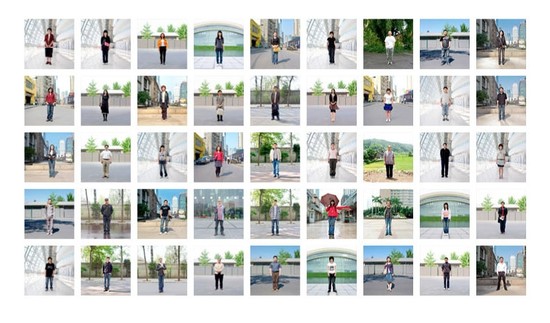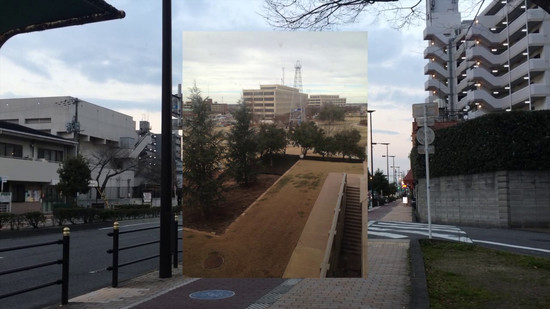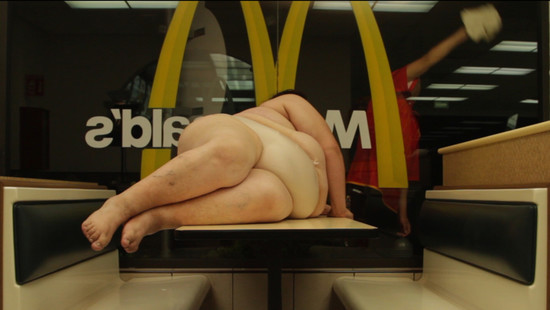Yoshua Okón, Freedom Fries: Still Life, 2014, Single-channel video on monitor (color, sound)
© the artist
One of the most thought-provoking works in Extra Bodies – The Use of the ‘Other Body’ in Contemporary Art, and one which encapsulates many of the confronting social questions this generation-spanning group exhibition poses, is one of its smallest and simplest. It is (Foto Ricordo) Seconda soluzione di immortalita (l’universa e immobile) (1972) by Italian artist Gino De Dominicis (whose influence was recently celebrated by Marina Abramovic). This black and white photo is of De Dominicis’s contribution to the 1972 Venice Biennale, in which three of his works were placed on display in a room. On the opening day, a young man with Down’s syndrome sat in the corner of the room contemplating the scene, as part of the artwork. De Dominicis’s ‘use’ of the man caused a furore at the latter’s apparent exploitation (the work was eventually removed in the wake of the scandal), and in this photo a female visitor appears to be gasping in horror.
Many of Extra Bodies’ wider preoccupations can be found in this piece: issues regarding the use of human beings in artworks, socio-political power dynamics, the intention to unsettle by twisting perspectives on certain groups (and the "specific social roles assigned to them by society" as the show’s blurb states), compassion towards the alienated and excluded, and simply satire and irony. De Dominicis’s 1972 performance work was recreated in London as part of Frieze Art Fair in 2006, this time with a woman with Down’s syndrome. Co-curator Maurizio Cattelan said at the time, "This is a complicit act. The woman in the piece is completely committed to the work; she is an actor." Again, this complicity is reflected across the rest of Extra Bodies: each work features the so-called outsider(s) deliberately and collaboratively subverting their own label and expectations about their values and motivations. Some big names are here too, from Yves Klein to Ai Weiwei, as well as some fairly famous works, such as Oscar Bony’s The Working Class Family (1968).
But first to consider that title. Extra Bodies – The Use of the ‘Other Body’ in Contemporary Art. I confess to having found it slightly difficult to envisage exactly what this might entail ahead of visiting the Migros Museum, which sits on the banks of the Limmat in Zurich’s north. The ambiguity was intriguing, with ‘extra’ bodies and ‘other’ bodies suggestive of two different things. ‘Extra’ bodies implies people as numbers and statistics as part of a mass group – perhaps as tools or objects in a wider game. The word ‘extra’ can suggest something expendable, so I anticipated works that addressed how war and warfare manifest a situation of extraneous personhood. I pictured assembly lines of people in both a military or indeed industrial setting.
‘Other’ bodies, however, I assumed related to those distinguished as ‘other’ in terms of either their physicality or their physical circumstances. And indeed this is borne out in De Dominicis’s work, while individuals with disabilities also feature (with complicity) in Artur Zmijewski’s video The Singing Lesson II (2002), in which a group of hearing-impaired youths perform a Bach cantata with predictably atonal results. The elderly can also count as ‘other’ bodies, thanks to Christophe Buchel’s No Future (2008), a video in which three OAPs have formed a garage band to perform the Sex Pistols’ ‘God Save The Queen’, as can the obese, with Yushua Okon’s Freedom Fries: Still Life (2014), showing an overweight model lying naked on a table in a McDonald’s. At the opposite end of the ‘other’ body spectrum are the extreme physiques of fashion models, as utilised in somewhat disturbing works by Vanessa Beecroft and L.A. Raeven. And then there are the bodies that become ‘other’ because of where they are: prison (another Zmijewski piece, The Making Of [2013]), on the street as criminals (Edwin Sanchez’s Clases de Cuchillo [2008]) or refugee camps (yet another Zmijewski work, Glimpse [2017]).
These preconceived ideas based on the show’s title proved accurate-ish. There turned out to be little that used war as a means to consider ‘extra’ bodies, the idea of which is most elegantly explored through Ai Weiwei’s much-critiqued, massive-scale project Fairytale (2007), exhibited as a video installation here. For the 2007 Documenta festival in Kassel, Germany, Ai organised for 1001 Chinese citizens to travel to Kassel as tourists, for free. The video shows the visa application process and interviews with both the artist and participants, while the other crucial component to the work is the availability of 1001 wooden chairs from the Qing and Ming dynasties to be placed in the exhibition space. In Zurich, there are 20–25 dispersed around the floor. Looked on as a group they are indistinguishable, yet, as the exhibition’s extensive accompanying notes point out, "upon closer inspection, they each [have] unique characteristics". Ai’s exercise in mass-tourism coupled with his chairs serves to challenge any idea that migrants and refugees are some single-minded mass with unity of purpose. For me, the work also highlights a peculiarly modern paradox: the fear of otherness can lead to hostility and resentment toward migrants and refugees, yet at the same time we are infected with the indoctrinated desire to experience different cultures and ‘broaden our horizons’, as a result of the commodification and commercialisation of travel.

Ai Weiwei, Fairytale People, 2007, C-print, 16 of 1001 parts: each 100 x 100 cm, © the artist
Adjacent to Ai’s work is a 2000 series of twelve colour photographs by Danish artist Jens Haaning. Each is a portrait of a first-generation refugee living and working in Copenhagen, shot as if they are participating in a ‘street style’ fashion feature that might appear in magazines and newspapers, complete with notes on clothing brands and prices: ‘Deniz’ is in "Tracksuit trouser by Adidas 200DKK" and "Nylon belt purse, present". Haaning’s series not only highlights the vacuity of this particular editorial concept, but also brings into stark focus how the reified worth of such migrants is seen as pure commodity. Both Ai and Haaning succeed in humanising those who exist in otherwise dehumanising contexts, and in identifying individuality amid stereotypes.
Another work that does this is Zmijewski’s The Making Of, a video that documents how the artist and his team, which included a make-up artist, stylist and hairdresser, visited a women’s prison near Warsaw. Willing inmates were given a comprehensive makeover and eventually performed a fashion show. Zmijewski explores the troubling idea that style is worth, and how certain ‘extra’ bodies on the fringes of society cannot register on the style spectrum. One senses genuine joy as the female inmates dress up and undergo their makeovers, yet there is also something unsettling and sad in the fact that in this instance individuality and expression depend on pre-packaged, culturally governed ideas of beauty. Furthermore, The Making Of is about femininity, and as a man I confess to having felt uncomfortable and unworthy passing any sort of judgement on how the behaviour and attitudes of these women offers insight in this way. One wonders how Zmijewski himself summoned the confidence to wrestle with this complex project that addresses, or tries to address, questions of gender expression.

Yuri Pattison, Outsourced Views, Visual Economies, 2013 – 2014, Single-channel video on flatscreen (HD, color, sound) © the artist
Moving away from the ‘extra’ bodies to the exhibition’s ‘other’ bodies, again the emphasis is on the female form. Test Room (2000), by L.A. Raeven (two Dutch collaborators), is a video piece that sees eight slim models stripped to their underwear and made to wait in an empty white anteroom for a casting project about which they know nothing. An uncomfortable kind of intimacy is formed as we witness the models twiddling their thumbs, requesting food and cigarettes and occasionally musing about what is going on but never rebelling against their situation lest they risk upsetting those powers that determine their careers and, you could say, sense of self. There is a certain ethical elasticity in the models’ eagerness to please, something the artists are surely highlighting, with this being one artwork in Extra Bodies where the bodies concerned may in fact not be complicit.
Vanessa Beecroft’s VB35: Performance (1998), displayed here as a print, is a similar examination of objectification and media, featuring an array of young women standing naked in rigid statuesque poses to reflect the demands put on them in their day-to-day life as models. Beecroft has crafted the scene with strict instructions for the models, who go to the limits of their physical capabilities by holding a pose for an interminable length of time. The women are – and this can also apply to Test Room as well as act as indictment of the fashion industry – "puppets without individuality, a screen upon which others can project their ideals and fantasies," as the accompanying text reads. Beecroft’s ‘other’ bodies are presented as objects of awe and desire, with these two artworks deconstructing and exposing the culture that idealizes them. They make for a sharp contrast to the ‘other’ bodies of De Dominicis or Zmijewski.
A word must also go to young Irish artist Yuri Pattison’s fantastic video installation, Outsourced Views, Visual Economies (2013-14). Pattison created an employer profile on an online ‘micro-work’ platform and posted an assignment where respondents the world over were asked simply to take a photograph of the view from whichever window was closest to their computer and send it back to Pattison. The artist accumulated a huge collection of images that he presents here as a slideshow on a screen. Pattison’s wider body of work makes urgent points about the changing nature of the globalised workplace, as does this piece, yet I could have watched this for hours simply for the fascinating insight it gives into the immediate surrounds of these faceless online workers: highways, jungle, billboards, desert, mountains, car parks and more. The viewer feels as if they suddenly have hundreds of pen pals.
Extra Bodies is an endlessly stimulating exhibition that challenges the reduction of human beings to any single identity. Each of these twenty-three artworks is an argument for pluralism in itself, so wandering through all of them is to bring dazzling, inspiring contradiction and complication to our socioeconomic readings of human beings and their strange institutions.
Extra Bodies – The Use of the ‘Other Body’ in Contemporary Art is at The Migros Museum for Contemporary Art, Zurich until 4 February


